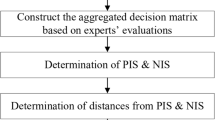Abstract
Privacy risk analysis of online social network (OSN) users aims at generating a risk score for each OSN user such that higher scores potentially imply a greater risk of privacy violation. Privacy risk analysis is typically carried out over a response matrix (R) where any matrix element \(r_{ij}\) indicates the portion of the OSN that the user i shares his/her attribute j. Most of the existing work relies on the mathematical framework of item response theory to derive sensitivity and visibility components from R. In this study, we propose interpreting R to be a term–document matrix and consequently suggest using the inverse document frequency (IDF) method as the sensitivity component. Experiments performed on both synthetic and real-world datasets show that the proposed IDF-based method can be used as a sensitivity component.


Similar content being viewed by others
Notes
Not all of user risk scores are given to save space.
References
Liu, K., Terzi, E.: A framework for computing the privacy scores of users in online social networks. In: Ninth IEEE International Conference on Data Mining, pp. 288–297 (2009)
Akcora, C., Carminati, B., Ferrari, E.: Privacy in social networks: how risky is your social graph?. In: IEEE 28th International Conference on Data Engineering, pp. 9–19 (2012)
Sramka, M.: Evaluating privacy risks in social networks from the user’s perspective. In: Navarro-Arribas, G., Torra, V. (eds.) Advanced Research in Data Privacy. Studies in Computational Intelligence, pp. 251–267. Springer, Cham (2015)
Aghasian, E., Garg, S., Gao, L., Yu, S., Montgomery, J.: Scoring users’ privacy disclosure across multiple online social networks. IEEE Access 5, 13118–13130 (2017)
Kosinski, M., Stillwell, D., Graepel, T.: Private traits and attributes are predictable from digital records of human behavior. Proc. Natl. Acad. Sci. 110(15), 5802–5805 (2013)
Mislove, A., Viswanath, B., Gummadi, P.K., Druschel, P.: You are who you know: inferring user profiles in online social networks. In: Proceedings of WSDM, pp. 251–260 (2010)
Vidyalakshmi, B.S., Wong, R.K., Ghanavati, M., Chi, C.H.: Privacy as a service in social network communications. In: IEEE International Conference on Services Computing, pp. 456–463 (2014)
Bioglio, L., Pensa, R.G.: Impact of neighbors on the privacy of individuals in online social networks. Procedia Comput. Sci. 108, 28–37 (2017)
Çoban, Ö., Özel, S.A.: Utilizing language model for term weighting in text categorization. In: International Conference on Artificial Intelligence and Data Processing, pp. 1–5 (2018)
Domingo-Ferrer, J.: Rational privacy disclosure in social networks. In: International Conference on Modeling Decisions for Artificial Intelligence, pp. 255–265 (2010)
Pensa, R.G., Di Blasi, G., Bioglio, L.: Network-aware privacy risk estimation in online social networks. Soc. Netw. Anal. Min. 9, 15 (2019)
Alemany, J., del Val, E., Alberola, J., Garcia-Fornes, A.: Estimation of privacy risk through centrality metrics. Future Gener. Comput. Syst. 82, 63–76 (2018)
Srivastava, A., Geethakumari, G.: A privacy settings recommender system for online social networks. In: International Conference on Recent Advances and Innovations in Engineering, pp. 1–6 (2014)
Yang, Y., Lutes, J., Li, F., Luo, B., Liu, P.: Stalking online: on user privacy in social networks. In: Proceedings of the Second ACM Conference on Data and Application Security and Privacy, pp. 37–48 (2012)
Talukder, N., Ouzzani, M., Elmagarmid, A.K., Elmeleegy, H., Yakout, M.: Privometer: privacy protection in social networks. In: IEEE 26th International Conference on Data Engineering Workshops, pp. 266–269 (2010)
Kılıc, Y., Inan, A. Privacy scoring over professional OSNs: more central users are under higher risk. In: International Conference on Advanced Technologies, Computer Engineering and Science, pp. 1–5 (2019)
Çoban, Ö., İnan, A., Özel, S.A.: Privacy risk analysis for Facebook users. In: 28th Signal Processing and Communications Applications Conference, pp. 1–4 (2020)
Li, X., Yang, Y., Chen, Y., Niu, X.: A privacy measurement framework for multiple online social networks against social identity linkage. Appl. Sci. 8(10), 1790 (2018)
Pensa, R.G., Di Blasi, G.: A semi-supervised approach to measuring user privacy in online social networks. In: International Conference on Discovery Science, pp. 392–407 (2016)
Symeonidis, I., Beato, F., Tsormpatzoudi, P., Preneel, B.: Collateral damage of Facebook Apps: an enhanced privacy scoring model. IACR Cryptol. 2015, 456 (2015)
Grauschopf, S.: Facebook privacy levels: understanding Facebook’s levels of privacy. Dotdash publishing (2019). https://www.thebalanceeveryday.com/understanding-facebook-s-privacy-levels-892796. Accessed 25 July 2021
Coban, O., Inan, A., Ozel, S.A.: Towards the design and implementation of an OSN crawler: a case of Turkish Facebook users. Int. J. Inf. Secur. Sci. 9(2), 76–93 (2020)
Author information
Authors and Affiliations
Corresponding author
Ethics declarations
Funding
The authors received no financial support for the research, authorship, and/or publication of this article.
Conflict of interest
The authors declare no conflict of interest.
Availability of data and materials
Data available on request due to privacy/ethical restrictions
Code availability
The code is available upon request.
Additional information
Publisher's Note
Springer Nature remains neutral with regard to jurisdictional claims in published maps and institutional affiliations.
Rights and permissions
About this article
Cite this article
Coban, O., Inan, A. & Ozel, S.A. Inverse document frequency-based sensitivity scoring for privacy analysis. SIViP 16, 735–743 (2022). https://doi.org/10.1007/s11760-021-02013-1
Received:
Revised:
Accepted:
Published:
Issue Date:
DOI: https://doi.org/10.1007/s11760-021-02013-1




